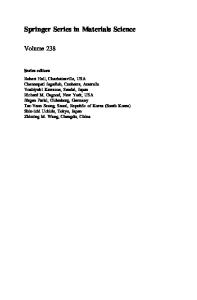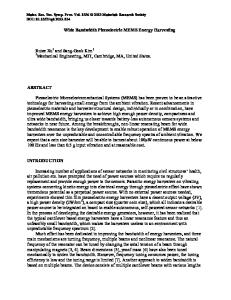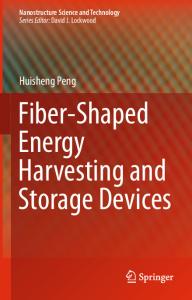Thermo-Magnetic, Piezo-Electric and Electroactive Energy Harvesting Devices
- PDF / 774,410 Bytes
- 12 Pages / 612 x 792 pts (letter) Page_size
- 58 Downloads / 274 Views
1218-Z04-03
Thermo-Magnetic, Piezo-Electric and Electroactive Energy Harvesting Devices Claire Jean-Mistral1,3, Louis Carlioz1,2, Maxime Defosseux1, Marcin Marzencki1, Orphée Cugat2, Jérôme Delamare2, Skandar Basrour1 1
TIMA CNRS / Grenoble INP / UJF, F38031 Grenoble, France
2
G2Elab Grenoble Electrical Engineering Lab, Grenoble-INP / UJF / CNRS, St Martin d'Hères F38402, France 3
CEA, LETI, MINATEC, Grenoble F38054, France
ABSTRACT We present three approaches to harvesting ambient energy, based on complementary physical effects in order to exploit three kinds of energy available for harvesting: Mechanical vibrations Mechanical vibration energy can be harvested with resonant mechanical structures excited by the vibrations; this scavenged energy is then transformed into electricity by piezoelectric materials. We propose to use thin piezoelectric layers deposited on the resonant structure. An on-chip integrated prototype, using a seismic mass at the end of a Si cantilever beam coated with a piezoelectric AlN film (overall volume 5 mm3), produces 30 nW of rectified power at 3 V under 0.4 g acceleration, which is enough to power a wireless sensor. Power conditioning electronics adapted to ultra-low voltage input is also proposed, which can efficiently charge a storage capacitor under very low accelerations. The fully micro-fabricated System on a Package combines a MEMS generator and ASIC power management circuit. Evolutions of ambient temperature A permanent magnet is attached to a PZT/brass bimorph, and placed near a "thermomagnetic" material (FeNi) which Curie temperature can be tuned around the ambient. During slow cooling or heating by the ambient air, the FeNi magnetic properties vary slowly and thus the attraction force between the FeNi and the NdFeB magnet varies slowly. Despite the slow global evolutions, the opposition between the linearity of the bimorph bending and the strong non-linearity of the magnetic attraction over distance leads to brutal clamping or release of the magnet around Tc: the piezo can then efficiently convert these fast deformations into electricity. Operational temperature range can be set by tuning the FeNi composition to obtain a predefined Curie point; hysteresis between the cooling/heating thresholds can be tuned by modifying the gap between the magnet and the FeNi. The cm-scale prototype generates a peak voltage of 35 V on release (T > Tc). For a discharge time of 0.1 s through a 1 MΩ load, the total energy harvested is 13.5 µJ per stroke, i.e. 1.35 mW
of average power (respectively -14 V, 2.2 µJ and 0.22 mW on clamping when T < Tc). Output power is surprisingly constant for various load values tested. Scaling effects must now be addressed to assess the feasibility of an integrated MEMS generator and its potential efficiency. Low-frequency, large amplitude bending from human motion: A very light, flexible electro-active polymer membrane (50 x 30 mm, 31 µm thick) operates in a large frequency spectrum from quasi-static to dynamic range. It scavenges 0.1 mJ per cycle at 1 Hz, un
Data Loading...











